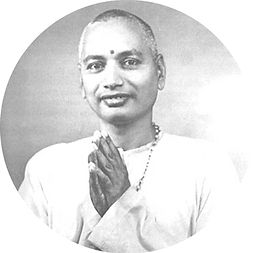
THE ISHTA LINEAGE (PARAMPARA) The spiritual vitality of ISHTA lives on.


KAVI YOGIRAJ MANI FINGER
Kavi Yogiraj Swarananda Mani Finger was born in 1908 in South Africa. At the age of 4 he met Mahatma Gandhi who patted him on the head and said “He will be a teacher and a philosopher”. Whilst on a business trip to Los Angeles, in 1946, he met Paramhansa Yogananda Giri who initiated him into the sacred techniques of Kriya Yoga. He said “Come; I’m going to teach you Kriya Yoga. It’s going to change your life. I want you to go to the Shivananda Ashram in India, and then go back to South Africa where you’ll become a famous yogi, and one of your sons will follow.” In 1962, he journeyed to Rishikesh, India, where he was initiated by Swami Sivananda Saraswati as a Yogiraj, which means Royal Seer or Sage. In 1971, Swaranandaji received initiation into Tantra by Kavi Yogiraj Shuddhananda Bharati. He then returned to South Africa where he taught, lectured and wrote for a newspaper.
YOGIRAJ ALAN FINGER
His son Alan Finger was 5 years of age, when his father returned to South Africa, from India. At that time, Kavi Yogiraj Swaranandaji would invite the swamis to stay with them and lecture there. Thus, their home was transformed into a partial hermitage (ashrama). Alan was very influenced by Swami Venkateshananda Sarasvati who would stay with them for as long as 3 months, during a year. Swami Nishraisananda Saraswati would stay for only 1 week at a time, and, in time, Shuddhanandaji contributed much to the Tantra practices at the hermitage.
It was at the age of 15 that Alan requested his father to teach him Yoga seriously. He had struggled with physical and mental afflictions, and felt that Yoga would benefit him. His father was a disciplinarian and told Alan that he would have to awaken at 4:30 every morning, and join him for over 3 hours of Yoga practices. Alan stated that “Immediately, it worked—I felt so much more clear and stable; the psychosomatic breathlessness and lightheadedness I was experiencing all went away. In four and a half years, I missed only two days of practice.”
Together with the swamis, the dynamic duo ordered and systematised the teachings that would later become the ISHTA (Integrated Science of Hatha, Tantra and Ayurveda). Swaranandaji chose the name ISHTA as a derivative of Yoga Sutras 2:44: svadhyayat ishta-devata samprayogah meaning “From self-study comes communion with one’s chosen personal deity.” This is at the heart of ISHTA: each person is different and requires assistance in those ”best” practices that suit one’s unique nature, ultimately leading to the unfoldment of one’s full potential as a human being - Self-Realisation (atma vidya).
THE SWAMIS ISHTA - a collaborative effort.


PARAMHANSA YOGANANDA GIRI
Paramhansa Yogananda (1893-1952) is widely revered as one of the preeminent spiritual figures of our time. Born in northern India, in Gorakhpur, on January 5, 1893, he took formal vows as a monk of India's venerable monastic Swami Order soon after graduating from Calcutta University in 1915. Two years later, he began his life's work with the founding of a "how-to-live" school - since grown to twenty-one educational institutions throughout India - where traditional academic subjects were offered together with the Yoga training and spiritual ideals.
In 1920, he was invited to the United States to speak at an interfaith congress of religious leaders, where he gave an historic address on "The Science of Religion." That same year he founded Self-Realisation Fellowship, an international society dedicated to, introducing throughout the world, his teachings on the age-old science and philosophy of Yoga and its time-honoured tradition of meditation; and to helping people of all races and creeds to realise and express more fully, in their lives, the beauty, nobility, and divinity of the human spirit.
During the more than thirty years that Paramhansa Yogananda lived and taught in the West, he contributed in far-reaching ways to a deepening awareness and appreciation of the ancient wisdom of the East.
"As a bright light shining in the midst of darkness, so was Yogananda's presence in the world. Such a great soul comes on earth only rarely, when there is a real need among men." - His Holiness Sri Chandrasekharendra Saraswati (1894 - 1994), the Shankaracharya of Kanchipuram

SWAMI VENKATESHANANDA SARASWATI
Swami Venkateshananda Saraswati was not only a friend of the revered Yoga master, T. Krishnamacharya but was, also, Swami Sivananda Saraswati’s “jewel student”. At the age of 14, after reading Swami Sivananda’s book, he requested to join him at his ashrama as a disciple. He served his guru as a compiler of literary works, as a correspondant, and in other day-to-day activities. In 1963, he was sent to South Africa to teach, and emerged as a powerful spiritual orator. In the 1970s, he travelled extensively, teaching the Yoga science to Truth-seekers worldwide.


SWAMI NISHRAISANANDA SARASWATI
Swami Nishraisananda Saraswati was a monk of the Ramakrishna Mission. Prior to embracing the life of a monk, he had worked as an engineer and scientist. He understood the links between spiritual Yoga and material science.


KAVI YOGIRAJ SHUDDHANANDA BHARATI
Kavi Yogiraja Shuddhananda Bharati was the founder of the Shuddhananda Bharati Desiya Vidyalayam High School in Shivaganga, South India. He was a prolific writer and wrote over 250 books. His magnum opus Bharata Shakti was a monumental and unique work, and within its pages he described his ideal: “One humanity living in communion with a single God in a world transformed!” He created a system of Yoga called Sama Yoga, a synthesis of material science and spiritual Yoga.

_hm.jpg)


